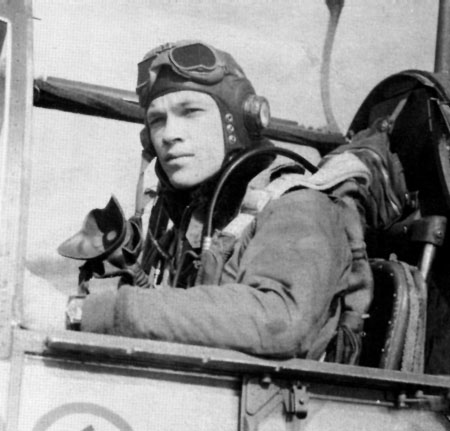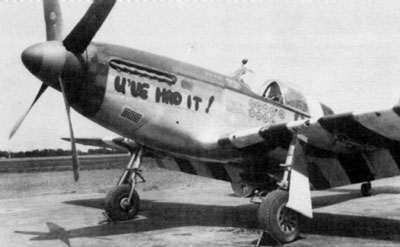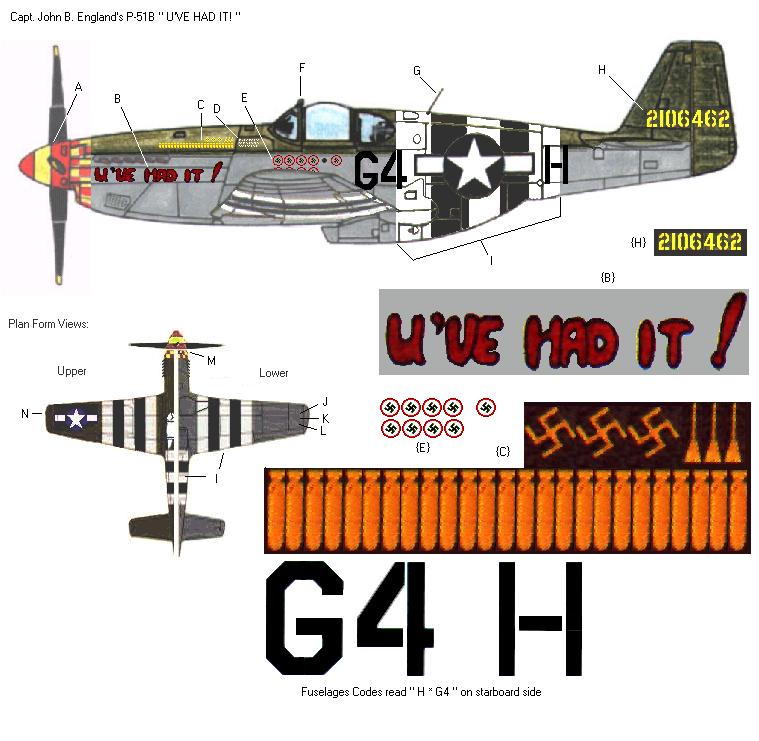357th FG Profile

Captain John England, 362nd FS, 2nd leading Ace of the 357th FG, 17 1/2 Victories

Capt. John “Johnny” B. England’s P-51B Mustang “U’VE HAD IT !” England AFB, LA, was named for Captain England

Summer, 1944
Modeler Tips:
A. Rear red band on propeller boss extends onto spinner to leading edge of blades when in neutral pitch. Determine width of yellow band by dividing remainder of spinner evenly.
B. “U’VE HAD IT !” in balloon lettering is red, outlined in black and fills entire lower strip panel. Exclamation point overlaps upper seam to level of exhaust stubs.
C. Single row of three yellow swastikas followed by three yellow brooms. Beneath that is a single row of twenty-five bomb-style mission marks.
D. White stencil listing pilot and ground crew names.
E. Nine kill marks, black swastikas over natural aluminum with red circle. Note space ahead of last kill mark in top row to accommodate signal pistol discharge opening.
F. Standard ETO half-sphere mirror, canopy frame is dark olive green.
G. 36″ Wire whip antenna.
H. Tail Number in yellow- “2106” on fin, “462” on rudder.
I. Full suite of invasion stripes, on both wings and fuselage.
Planform View Notes:
I. Same as item’s I, above. J, K, L. Red, Green, Yellow navigation lights- circular and flush with wing panel.
M. Width of checker reduced on underside in order to fit evenly on the narrow surfaces of the chin scoop area.
N. Formation Lights- Red (Port) and Green (Starboard)
Overall Modeling Tips:
*This aircraft had olive drab upper surfaces, natural metal underneath. Paint on the flat colors first (invasion stripes, camouflage areas, yellow nose band)- then mask off and paint remainder a natural aluminum color. Most metal colors will be marred or removed by masking materials so it’s often better to leave them for last.
*After building several 357th A/C over the past 30 years, I recommend painting the nose area forward of the exhaust cutout yellow when the flat features are painted. Carefully cut away the yellow squares from the checkerboard decal and apply the remaining strip of red checkers to the nose. This method significantly reduces the potential for bubbles, and wrinkles plus it makes exact alignment of the decal easier.
*Prior to assembly, wash clear plastic parts with a mild glass cleaner and gently wipe dry. Then use a Q-Tip to evenly spread clear liquid floor wax (Future Brand seems to get the best results) on both inside & outside. Protect from dust and let dry for at least 2 hours. The wax fills in microscopic flaws and creates an even gloss that is clearer & shines brighter than the original plastic underneath.
SuperScale Decal Sheet 48-90

